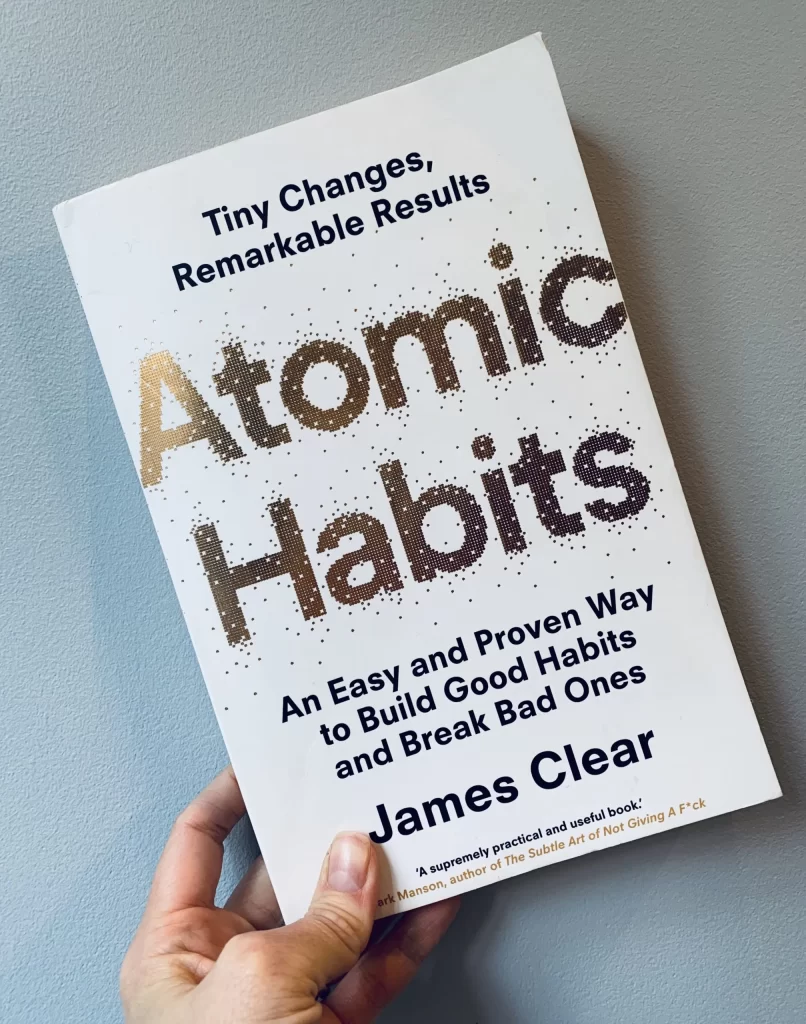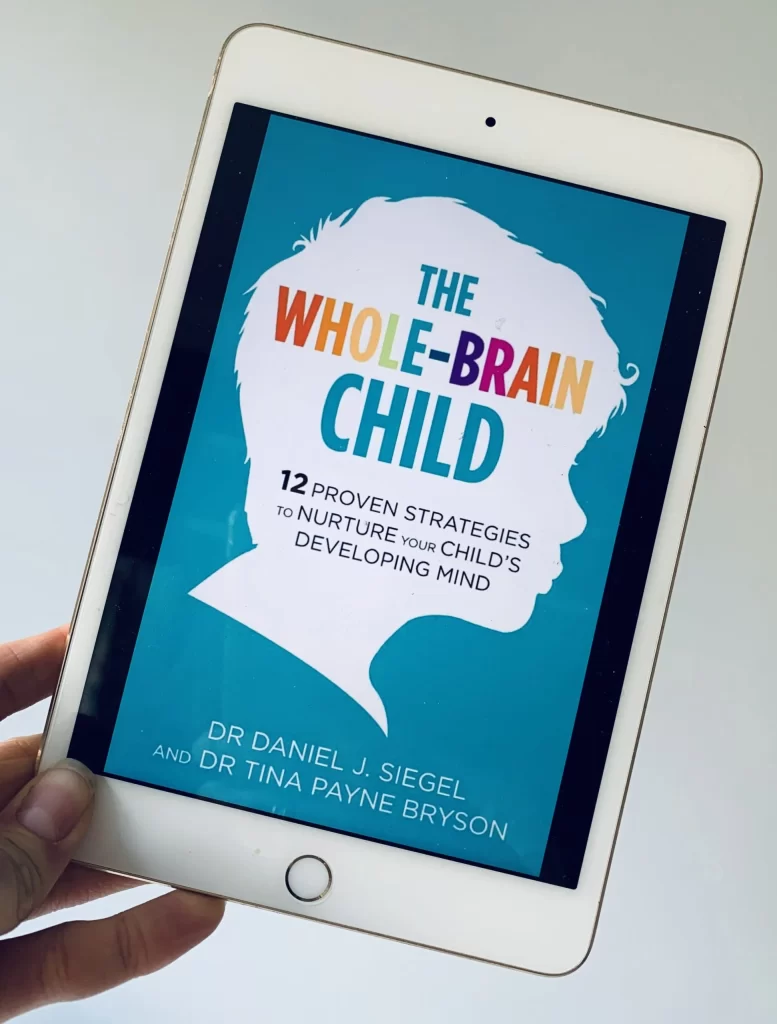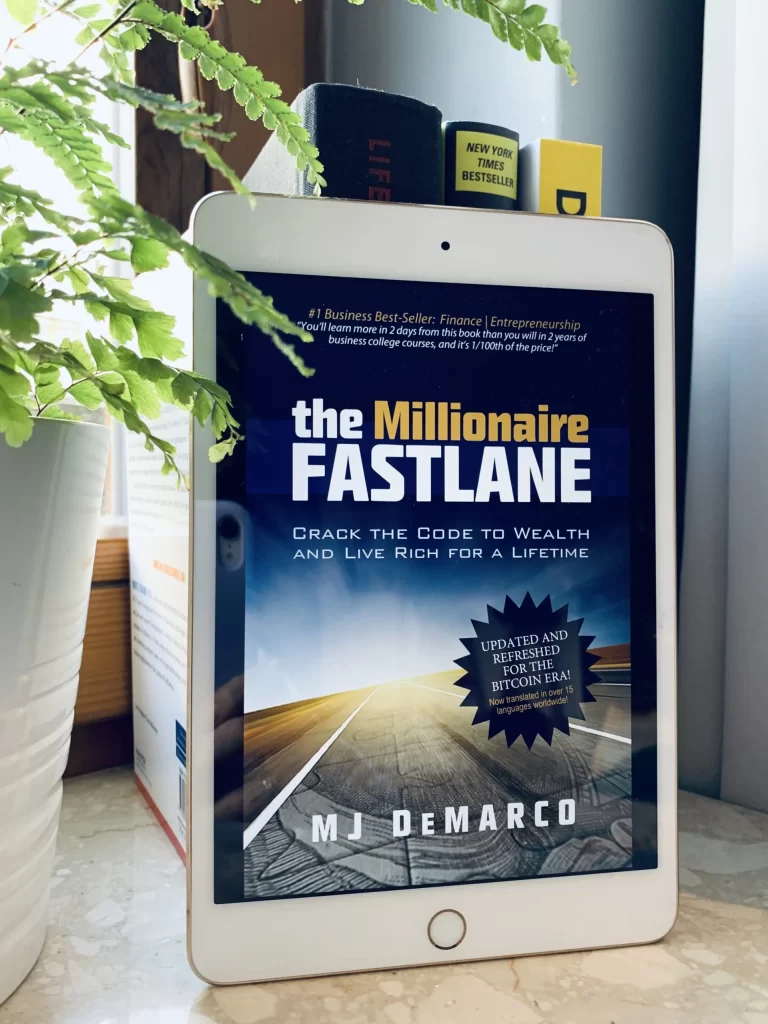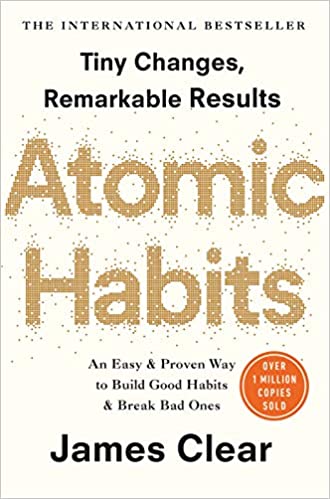 Atomic Habits – book summary
Atomic Habits – book summary
An Easy and Proven Way to Build Good Habits and Break Bad Ones
James Clear
Penguin (18 Oct. 2018)
ABOUT THE AUTHOR:
James Clear is a popular writer and speaker focused on habits, decision-making and continuous improvement. Millions of people visit his popular blog each month, and hundreds of thousands of people subscribe to his 3-2-1 newsletter. He is a founder of Habits Academy and a regular speaker at Fortune 500 companies.
About the book:
James Clear spent years studying the science of habits. In this ground-breaking book, he reveals how tiny changes (atomic habits) can grow into life-altering outcomes. Clear distils the most fundamental information about habit formation and shows us how we can apply this knowledge to our lives. He shares a handful of very practical science-backed life hacks, which can help us achieve more by focusing on less. This book is also super helpful for parents, as it’s a great manual on behaviour change.
Key Ideas from the book:
Tiny changes lead to remarkable results
“It is so easy to overestimate the importance of one defining moment and underestimate the value of making small improvements on a daily basis. Too often, we convince ourselves that massive success requires massive action. Whether it is losing weight, building a business, writing a book, winning a championship, or achieving any other goal, we put pressure on ourselves to make some earth-shattering improvement that everyone will talk about.
Meanwhile, improving 1 percent isn’t particularly notable—sometimes it isn’t even noticeable—but it can be far more meaningful, especially in the long run. The difference a tiny improvement can make over time is astounding. Here’s how the math works out: if you can get 1 percent better each day for one year, you’ll end up thirty-seven times better by the time you’re done. Conversely, if you get 1 percent worse each day for one year, you’ll decline nearly down to zero. What starts as a small win or a minor setback accumulates into something much more.
Habits are the compound interest of self-improvement. The same way that money multiplies through compound interest, the effects of your habits multiply as you repeat them. They seem to make little difference on any given day and yet the impact they deliver over the months and years can be enormous. It is only when looking back two, five, or perhaps ten years later that the value of good habits and the cost of bad ones becomes strikingly apparent.”
How to become better at anything that you do? By becoming 1% better every day. Embrace the philosophy of improving everything you can, even the slightest, tiny thing to create a compound effect – “The aggregation of marginal gains”, as Dave Brailsford (Performance director of British Cycling Team) puts it.
These small improvements (or tiny habits) added into our everyday routines can accumulate over a long time and make an enormous difference. The math behind it is impressive – if we can get 1% better every day for one year, we’ll end up 37 times better by the time we are done. Now, using the same formula, calculate how much you can improve if you keep getting 1% better every day for one more year? You can become 1400 times better! Now think about where you can be in 5 years?
James writes that if we want to experience the magic of compound growth, we need to work on our behaviour – our habits:
“Habits are like atoms of our lives. Each one is fundamental unit that contributes to your overall improvement. At first, these tiny routines seem insignificant, but soon they build on each other and fuel bigger wins that multiply to a degree that far outweighs the cost of their initial investment. They are both small and mighty… Atomic Habits – a regular practice or routine that is not only small and easy to do but also the source of incredible power; a component of the system of compound growth.”
Atomic habits are tiny behaviours that we could easily implement in our lives. Each of those habits would seem insignificant when alone, but when stacked up together, they make a difference. Those routines gradually will help us create a system of tiny habits – a system of small goals which we can reach automatically. And as a result, it can become a strong foundation for achieving mighty things as compound effect grows (1% a day ;))
As Confucius said: “A journey of a thousand miles starts with a single step”.
Everyone has potential, and with the right approach, we can accomplish much, much more in our lives.
Goals vs Systems
“The purpose of setting goals is to win the game. The purpose of building systems is to continue playing the game. True long-term thinking is goal-less thinking. It is not about any single accomplishment. It is about cycle of endless refinement and continuous improvement. Ultimately, it is your commitment to the process that will determine your progress.”
It’s important to set goals, and everyone should do it. But building systems is even more critical if we want to achieve great things in our lives. Systems give us two important things: internal motivation and flexibility to improve the process (ultimately driving the results).
Some people see goals as big dreams with huge milestones and then struggle to achieve them. But when we create a system and break our big goal down into thousands of tiny goals (a micro plan), we create a clear path on how to get there. This system makes it much easier to track the actual progress, receive meaningful feedback and “continue playing the game”.
Therefore, James says that we need to focus more on things that we can do right here and right now, but which bring us one step closer to our big goal:
“Goals are good for setting the direction, but systems are best for making progress. A handful of problems arise when you spend too much time thinking about your goals and not enough time designing your systems.”
Identity based habits stick with you
“Identity change is the North Star of habit change. The remainder of this book will provide you with step-by-step instructions on how to build better habits for yourself, your family, your team, your company, and anywhere else you wish. But the true question is: ‘Are you becoming the type of person you want to become?’ The first step is not what or how, but who. You need to know who you want to be. Otherwise, your quest for change is like a boat without a rudder. And that’s why we’re starting here.
You have the power to change your beliefs about yourself. Your identity is not set in stone. You have a choice in every moment. You can choose the identity you want to reinforce today with habits you choose today. And this brings us to the deeper purpose of this book and the real reason habits matter.
Building better habits isn’t about littering your day with life hacks. It’s not about flossing one tooth each night or taking a cold shower each morning or wearing the same outfit each day. It’s not about achieving external measures of success like earning more money, losing weight, or reducing stress. Habits can help you achieve all of these things, but fundamentally they are not about having something. They are about becoming someone.
Ultimately, your habits matter because they help you become the type of person you wish to be. They are the channel through which you develop your deepest beliefs about yourself. Quite literally, you become your habits.”
Before you even start thinking about WHAT you want to achieve and HOW you need to have a clear vision of WHO you wish to become.
A healthy person? A fit athlete? A great partner/father/mother? A productive person?
Once you know WHO you want to be, you can start building a system of tiny habits to BECOME that person:
“The more you repeat a behavior, the more you reinforce the identity associated with that behavior. In fact, the word identity was originally derived from the Latin word essentitas, which means being, and identidem, which means repeatedly. Your identity is literally your “repeated beingness.'”
You are what you repeatedly do. Once you match your identity with your behaviour, you literally become WHO you want to become.
James also shares this model of change:
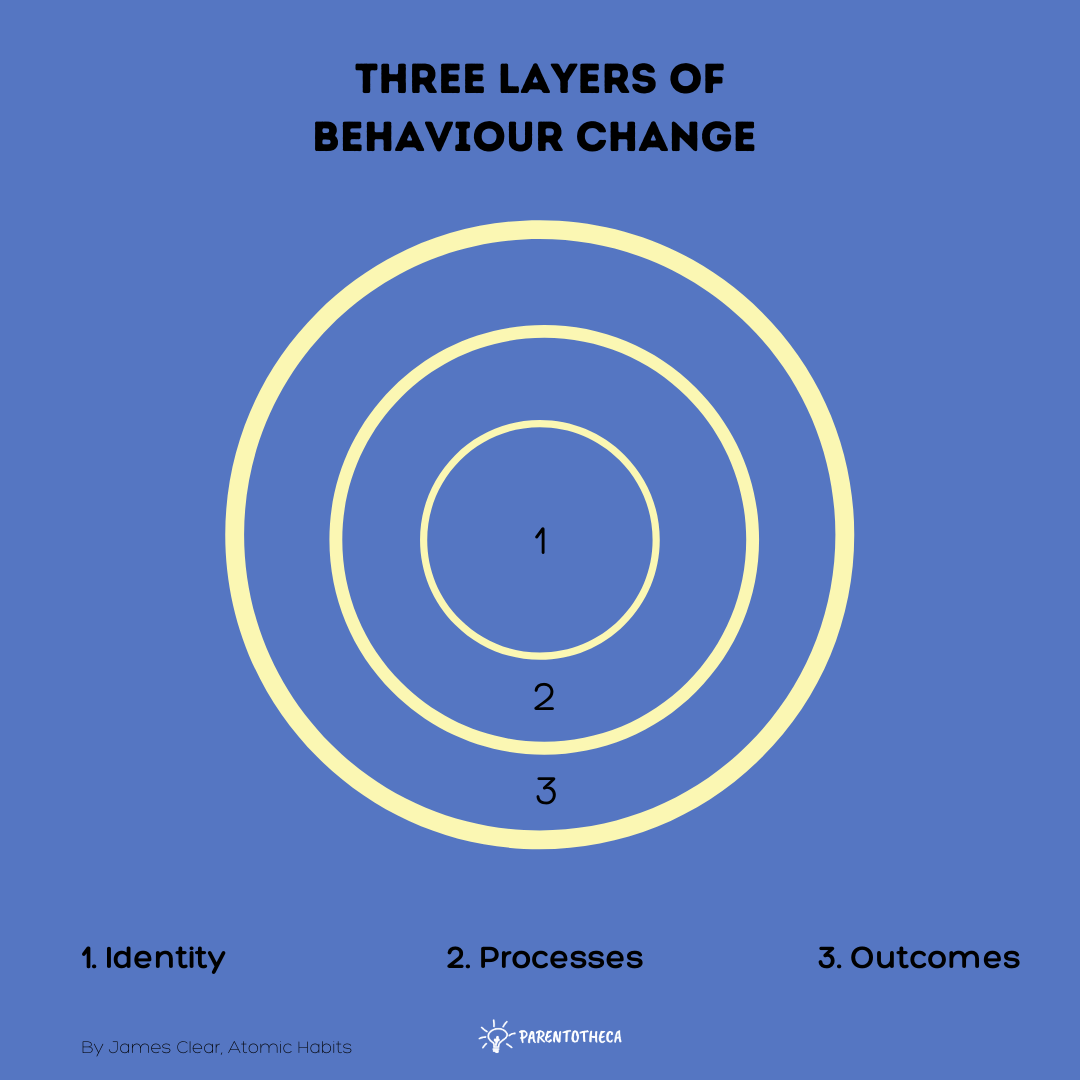
If you focus only on the outcome (the result), then the habit would never stick with you, as your motivation is externally driven. To achieve anything meaningful, you need intrinsic motivation to ACT – that’s why you need to start with your identity first – who you want to become.
The Four Laws of Behaviour Change
“If a behavior is insufficient in any of the four stages, it will not become a habit. Eliminate the cue and your habit will never start. Reduce the craving and you won’t experience enough motivation to act. Make the behavior difficult and you won’t be able to do it. And if the reward fails to satisfy your desire, then you’ll have no reason to do it again in the future. Without the first three steps, a behavior will not occur. Without all four, a behavior will not be repeated.
In summary, the cue triggers a craving, which motivates a response, which provides a reward, which satisfies the craving and, ultimately, becomes associated with the cue. Together, these four steps form a neurological feedback loop—cue, craving, response, reward; cue, craving, response, reward—that ultimately allows you to create automatic habits. This cycle is known as the habit loop.”
The four steps (Cue + Craving + Response + Reward) form the “habit loop”, and that’s the basis for the 4 Laws of Behaviour Change.
We have a CUE in our environment that leads to a CRAVING (desire) to do something, we RESPOND, and THEREFORE we get a REWARD, which satisfies the desire and reminds us of the CUE… repeated habit loop.
How to create a good habit and break the bad habit? Below are simple steps to follow:
|
Steps/laws of Habit LOOP |
How to Create a Good Habit |
How to Break a Bad Habit |
| The 1st law (Cue) |
Make it obvious |
Make it invisible |
| The 2nd law (Craving) |
Make it attractive |
Make it unattractive |
| The 3rd law (Response) |
Make it easy |
Make it difficult |
| The 4th law (Reward) |
Make it satisfying |
Make it unsatisfying |
In the book, James gives plenty of examples for each of those Laws to demonstrate how we can apply this wisdom to our lives and makes it SUPER EASY… Check out the book for inspiration.
Following these Laws, let’s take a QUICK look at how to form a new habit.
Let’s say we want to eat porridge in the morning.
Law #1: Make it obvious. James tells us we should use implementation intentions such as, “I will eat a porridge first thing in the morning in the kitchen.” (Note: WHEN and WHERE stated loudly are super important. Be as precise as you can). You can also make the cue obvious by “designing your environment.” Perhaps you could prepare ingredients a night before and leave them on the kitchen counter so it will be hard to miss. That is “obvious.” (Or, if you want to run every morning, put your running shoes between bedroom and bathroom, so you could trip over them, etc.)
Law #2: Make it attractive. Add your favourite topping (fruit/berries/nuts); think about all the research demonstrating the benefits you want—a healthy body, lower cholesterol etc. You can also pair it with something you really enjoy doing, like drinking a cup of tea or coffee AFTER you eat – it is called “habit stacking”: add a new habit before the old one, as a reward). Another good way: “Join a culture where your desired behavior is the normal behavior.”
Law #3: Make it easy. As easy to start as it is possible – “downscale your habits until they can be done in two minutes or less.” (“atomic” -mini behaviour that leads to the bigger habit.) For example, use a multicooker – just add oats and milk/water, press the “On” button, and your porridge is ready in no time, or use topping, which you don’t need to cut in advance. The crucial IDEA in making it EASY is to “Master the decisive moment. Optimise the small choices that deliver outsized impact.”
Law #4: Make it satisfying. You need an immediate reward after doing your new habit … maybe a cup of tea or coffee? James tells us to never miss twice and recommends using a habit tracker, so you do not break the chain. The longer you perform your habit, the more satisfying it will be.
So what would be your one desired behaviour that you would like to start today?
Follow the 4 Laws. And… Do the opposite for the things you want to eliminate. Let’s say we want to watch less TV? ☺
First: Make it invisible (not obvious). How? Hide (or sell) TV. Make it INVISIBLE. (Why? Well, when it’s “obvious”/insight, what do you do? You watch it!)
Second: Make it unattractive. “Reframe your mind-set. Highlight the benefits of avoiding the bad habits.” For example, imagine what else you could do during that time that you enjoy, etc.
Third: Make it difficult. “Increase friction” by increasing the number of steps between you and your bad habits. For example, take batteries out of the remote control, unplug the TV, etc.
Fourth: Make it unsatisfying. Keep that reframe from above in mind and make the connection between your lack of energy and watching TV late at night!
So why not take ACTION… if you feel inspired, think about the number one good habit you would like to install and the number one bad habit you would like to break.
P.S.: Check out our notes on The Compound Effect by Darren Hardy – one of the best books on habits.
The truth about talent
“The secret of maximising your odds of success is to choose the right field of competition. This is just as true with habit change as it is with sports and business. Habits are easier to perform, and more satisfying to stick with, when they align with your natural inclinations and abilities. Like Micheal Phelps in the pool or Hicham El Guerrouj on the track, you want to play a game where the odds are in your favour.”
We are all born with different abilities, and if we choose a field where we have natural talents, we can maximise our chances for success. The point is that it’s highly unlikely that Michael Phelps could become an Olympic runner with deliberate practice, or Hicham El Guerrouj could become a swimmer, but both of them had natural abilities which helped them to excel in their chosen sport. So “competence is highly dependent on context”.
When we follow our natural talents, it’s easier to create a system of habits that lead us to great results.
So parents (and not only), help your children try as many different activities as possible to test what they like, what comes easier to them before “specialising”. After this exploration period, children could focus their attention and energy on one priority that suits their natural abilities and personality… and experiment occasionally to achieve the best results.
To clarify: Once you know your strong points (re skills and personality), put your energy and attention to achieve remarkable things. Basically, work on your grit and don’t forget about deliberate practice.
Goldilocks Rule
“The Goldilocks Rule states that humans experience peak motivation when working on tasks that are right on the edge of their current abilities. Not too hard. Not too easy. Just right.”
It’s much easier to stay motivated and keep going towards your desired behaviour (or habit) when you are actually enjoying what you do 🙂
Goldilock zone is between BOREDOM (something is too easy) and FAILURE (too hard). That’s pretty much exactly what Mihaly Csikszentmihalyi calls the “FLOW” state (high level of enjoyment). As he tells us: “Enjoyment appears at the boundary between boredom and anxiety, when the challenges are just balanced with the person’s capacity to act.”
How about challenging ourselves just a bit, so we are not BORED, by creating a system of good habits… and becoming 1% better today?
Action steps for you:
- WHO would you like to become?
- Think about one new HABIT that you would like to HAVE and make it: obvious, attractive, easy and satisfying to do.
- Think about how you can “design a world where it’s easy to do what’s right”? Make a plan and just do it 🙂
Quotes from the book:






